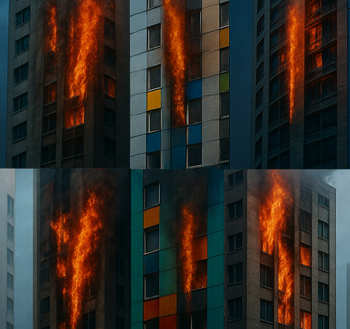Overheating in buildings
Contents |
[edit] Introduction
The term 'overheating' refers to discomfort to occupants caused by the accumulation of warmth within a building. It is considered to be a growing problem in the UK due to climate change, the urban heat island effect, electronic equipment, increasing amounts of glazing and so on.
CIBSE define overheating as: 'conditions when the comfortable internal temperature threshold of 28°C is surpassed for over 1% of the time.' They also define 35°C as the internal temperature above which there is a significant danger of heat stress.
In 2006, the Trades Union Congress (TUC) stated that it believed a maximum temperature of 30ºC should be set, or 27ºC for those doing strenuous work. In July 2019, the Labour party proposed the same maximum workplace temperature of 30ºC, or 27ºC for those doing strenuous work. They tasked a proposed Royal Commission on Health and Safety at Work with bringing forward proposals.
For more information see: Heat stress.
Overheating can result in serious health issues, particularly amongst the elderly or young children. The summer heat wave of 2003 recorded an increase of 2,000 deaths in the UK due to heat exposure. It is predicted that by the 2080s this figure could have risen to as much as 5,000.
[edit] Design causes of overheating
Some of the reasons for overheating are thought to be modern building fabric standards that aim to keep buildings warm in colder climates. The House Builder's Association have been reported as saying that 'the ever exacting standards' of Building Regulations Part L cause overheating by stipulating airtightness levels that are too high.
Overheating may be caused by a single predominant factor or as a cumulative effect of different factors. These include:
- Solar radiation passes through glass and heats internal surfaces, which re-radiate long wave infra-red radiation that cannot pass through glass. This is known as the greenhouse effect.
- Double-glazed windows reduce heat losses through conduction.
- Increasingly high levels of insulation reduce heat transmission across the building fabric.
- The activities of occupants such as cooking, bathing, showering all generate heat. Electrical appliances generate heat when in use.
- Occupants themselves generate heat, the amount of which is dependent on their activity level.
- If a site is in close proximity to airborne noise, pollution or odour from busy roads, railways or industrial sites, occupants will be reluctant to open windows and so heat will accumulate inside.
- Urban heat island effect is primarily caused by the replacement of natural surfaces with hard impervious surfaces that are generally dark and absorb large amounts of solar radiation. Urban hard surfaces are significant in the built environment in the form of roads, paved areas, roof tops and so on.
- Buildings oriented with south facing glazing may accumulate high levels of solar gain.
- Overheating problems may be contributed to by heat gain from boilers, hot water storage and distribution and other building services systems. This can be a particular problem in apartment buildings that have community heating pipework.
- Increasing levels of airtightness can reduce the amount of 'fresh' air entering a building.
[edit] How to deal with overheating
- Orientation and footprint can be designed to minimise solar gain and maximise opportunities for cross ventilation, stack ventilation and so on.
- High-performance glazing such as low-e glass, smart glass and so on can reduce heat gains. Smart glazing can be manually or automatically adjusted to control the amount of light, glare or heat that passes through. Whilst the price is decreasing it is still a very expensive option and as such is most likely to be found in commercial developments.
- Adjustable blinds can allow some internal control over solar gains.
- External shading such as canopies, louvres and shutters may help to prevent overheating. Intelligent facades can give control over climate exposure.
- Glazing ratio: Large expanses of glazing increase solar gain and make a building more susceptible to overheating. However, large windows also admit natural light. Glazing ratios try to achieve an equilibrium between these two positions.
For more information, see Preventing overheating.
NB LETI Climate emergency retrofit guide, How existing homes can be adapted to meet UK climate targets, published by LETI in October 2021, defines overheating as: ‘The condition where the internal temperature of a dwelling, typically in summer, spends a certain amount of time above what is considered comfortable. Exact limits vary depending on the standard, but typically anything above 25ºC could be considered overheating.’
[edit] Regulation
Approved Document O was published on 15 December 2021 as part of the government’s plans to deliver net zero. It covers overheating mitigation requirements for new residential buildings:
- Limiting unwanted solar gains in summer.
- Providing an adequate means to remove heat from the indoor environment.
The aim of requirement is to protect the health and welfare of occupants of the building by reducing the occurrence of high indoor temperatures.
For more information see: Approved Document O.
[edit] Related articles on Designing Buildings
- Approved Document O.
- Better prediction of overheating in new homes.
- Comfort in low energy buildings.
- Evolving opportunities for providing thermal comfort.
- Good homes alliance overheating tool
- Heat pumps and heat waves: How overheating complicates ending gas in the UK.
- Heat source.
- Heat stress.
- Heating.
- Heatwave.
- Home Quality Mark high temperature reporting tool.
- Human comfort in buildings.
- Maximum and minimum workplace temperatures.
- Overheating - assessment protocol.
- Overheating in residential properties.
- Preventing overheating.
- Temperature.
- Thermal comfort.
- Thermal indices.
- Thermal pleasure in the built environment.
- Types of heating system.
- Urban heat island.
- When hospital buildings aren’t healthy.
[edit] External references
- Building – Tackling overheating in UK homes
- Zero Carbon Hub – Understanding Overheating
- Research - Overheating in buildings: adaptation responses http://www.tandfonline.com/toc/rbri20/45/1-2
- Overheating in buildings: lessons from research http://www.tandfonline.com/doi/full/10.1080/09613218.2017.1256136
Featured articles and news
Government consultations for the summer of 2025
A year of Labour, past and present consultations on the environment, the built environment, training and tax.
CMA competitiveness probe of major housing developers
100 million affordable housing contributions committed with further consultation published.
Homes England supports Greencore Homes
42 new build affordable sustainable homes in Oxfordshire.
Zero carbon social housing: unlocking brownfield potential
Seven ZEDpod strategies for brownfield housing success.
CIOB report; a blueprint for SDGs and the built environment
Pairing the Sustainable Development Goals with projects.
Types, tests, standards and fires relating to external cladding
Brief descriptions with an extensive list of fires for review.
Latest Build UK Building Safety Regime explainer published
Key elements in one short, now updated document.
UKGBC launch the UK Climate Resilience Roadmap
First guidance of its kind on direct climate impacts for the built environment and how it can adapt.
CLC Health, Safety and Wellbeing Strategy 2025
Launched by the Minister for Industry to look at fatalities on site, improving mental health and other issues.
One of the most impressive Victorian architects. Book review.
Common Assessment Standard now with building safety
New CAS update now includes mandatory building safety questions.
RTPI leader to become new CIOB Chief Executive Officer
Dr Victoria Hills MRTPI, FICE to take over after Caroline Gumble’s departure.
Social and affordable housing, a long term plan for delivery
The “Delivering a Decade of Renewal for Social and Affordable Housing” strategy sets out future path.
A change to adoptive architecture
Effects of global weather warming on architectural detailing, material choice and human interaction.
The proposed publicly owned and backed subsidiary of Homes England, to facilitate new homes.
How big is the problem and what can we do to mitigate the effects?
Overheating guidance and tools for building designers
A number of cool guides to help with the heat.
The UK's Modern Industrial Strategy: A 10 year plan
Previous consultation criticism, current key elements and general support with some persisting reservations.
Building Safety Regulator reforms
New roles, new staff and a new fast track service pave the way for a single construction regulator.


























Comments